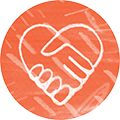Step 5: Do the influencing
This section provides you with some guidance on how to go forward into ‘influencing’ mode, putting your preparation into action.
 Spotlight on learning from local partner Moray Wellbeing Hub
Spotlight on learning from local partner Moray Wellbeing Hub
The content displayed on this page was produced by Moray Wellbeing Hub and describes their reflections, experiences and learning over the years about lived experience leadership in driving change in healthcare / mental health services.
Visit Moray Wellbeing HubNow you are well prepared, it’s time to put this in to action. When you are in ‘influencing’ mode you could consider the following tips
- Focus on impact, not medical language like diagnosis: Although a useful tool for professionals, information on diagnosis is rarely as relevant to the general public as the effects an illness has on a person’s life. It can also lead to people ’othering’ certain groups as they focus on what is different under specific labels
- You are an expert in your own experience: Focusing on what you know well is powerful. Work out what you are willing to share, and to what audience
- Use personal testimony from others: Research what others have experienced by reading testimony from others through trusted website resources, as well as asking peers and looking at other research by mental health organisations. Get permission if you are going to quote directly from an individual, or reference the organisation you used as a source. See Me have a wealth of excellent resources to support changing minds in healthcare and other settings.
- Have pre-prepared information on hand: This might mean carrying a few leaflets or information sheets with you, or bookmarking key websites on your phone. It may even mean preparing notes or slides. Having an aid when you are sharing information gives you confidence to know you don’t need to be an expert, just enthusiastic
“In my experience it is important to share awareness of what stigma is regardless of what role someone does, it's in all of us to suffer challenges and as friends, carers, professionals we can support others without the opportunity for support. Talking is part of the journey/breaking down the stigma.”
Moray workshop participant, 2024
Different levels of involvement
Influencing change is often about small steps. This means anyone can get involved, regardless of how much time and how visible they want to be as a peer of life challenges. There is a table in document 3 that compares different opportunities for involvement.
TIP! - Reach, visibility and time do not guarantee greater success in creating change. Small actions can lead to big change!
“The action group makes me feel empowered, like we are doing something together. We looked at the paperwork for the recommissioning of the drug and alcohol support service. Together we added lots of edits, changed the language and asked for more peer focused things. They accepted every change we made and that was what was used in the selection of the new service. We were proud as a group and they were really proud too because they have changed things to make this happen, not wanting to be tokenistic.”
Moray Drug & Alcohol Lived/Living Experience Group Member, 2024
Lived experience example of mental health stigma and discrimination in healthcare
Firstly, Mary writes a draft of her letter to the GP practice and for CareOpinion. This has the complaint, how it impacted her, the feedback from others as quotes, the improvement plan suggestion, link to the resources, and some facts on the impact of live testimony from peers from Scottish Recovery Network. She then takes it to a different friend who reads it and helps her with the tone of the letter. She sends it to the practice by email and to CareOpinion.
